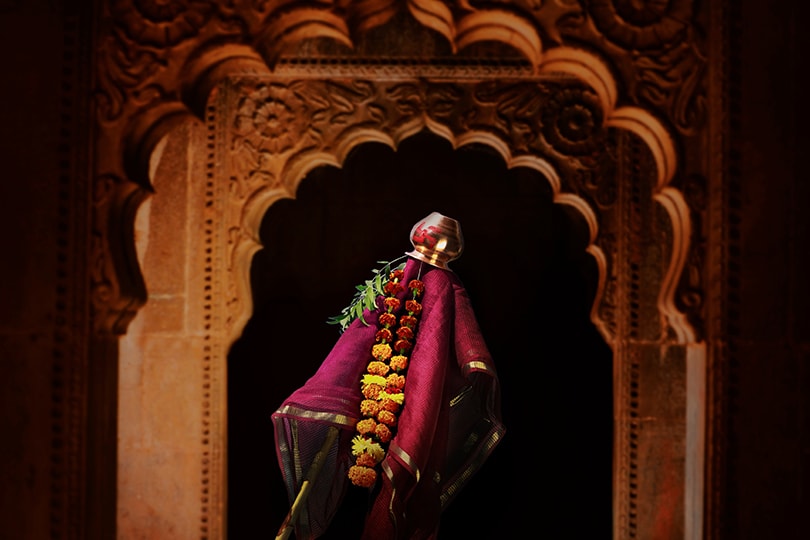

Gudi Padwa is a colourful and joyous festival celebrated in Maharashtra, India. It symbolises the arrival of spring and serves as the New Year for Marathi and Konkani Hindus. The festival is named after the Brahma flag, known as ‘Gudi,’ which is hoisted to commemorate the victory of good over evil.
On this day, Maratha Hindus dress in traditional attire to celebrate the beginning of a new year and harvest season. According to the Lunisolar Hindu Calendar, Gudi Padwa takes place on the first day of Chaitra, typically in March or April. The festival holds deep significance and is also known as Ugadi and Yugadi in different regions of India.
Gudi Padwa is steeped in Hindu mythology and history. According to the Puranas, the day marks the start of the era of truth and justice known as ‘Satyug.’ The festival is associated with Lord Brahma, who is believed to have recreated the world after destroying it in anger and restarting time on Gudi Padwa.
Lord Brahma is also worshipped on this day, as it is said that he established the concept of days, weeks, months, and years. Another significant tale connected to the festival is the return of Lord Rama, his wife Sita, and brother Laxman, to Ayodhya after their exile. Upon their arrival, Lord Rama was crowned, and the ‘Brahmadhvaj’ was raised at the entrance of Ayodhya to celebrate their victory. The festival is also said to commemorate Lord Rama’s triumph over Bali.
The Gudi is made by tying a red, yellow, or green cloth to the tip of a bamboo stick. Mango and Neem leaves are then wrapped around the fabric and decorated with sugar crystals and garlands.
A swastika symbol is drawn using kumkum, and an inverted copper or silver pot is placed over the cloth. The Gudi is then placed at the entrance or window of the house, facing the right side. The mantras are then recited, and a Bhog or offering is made to the Gudi.
Gudi Padwa is greatly cherished by the people of Maharashtra, particularly the Marathis. They associate the festival with a significant victory of the Maratha Kingdom’s founder, Chhatrapati Shivaji, over General Kartalab Khan’s army in the Battle of Umberkhind in the Sahyadri mountain range on February 3, 1661.
This victory is a reason for the Maratha people to celebrate Gudi Padwa with much enthusiasm and belief in its power to ward off evil and bring prosperity and good luck. The festival holds a special place in the hearts of Marathis and is deeply rooted in their cultural and historical heritage. This is why people from far away come here during this festival and stay in family hotels in the area to enjoy this festival.
Gudi Padwa is a momentous day for Hindus in Maharashtra. They start the day by waking up early and performing various rituals. One of the first rituals is to wash the front floor of their homes and decorate it with colourful designs, such as Rangolis made from flower petals and cow dung cakes. In rural areas, some people use water mixed with cow dung for washing their yards.
On this day, people take special baths and place an earthen pot filled with neem leaves, flowers, and even coconuts. They then erect a bamboo stick with shiny cloth tied on top, which symbolises victory. A pot or a garland of flowers is hung from the other side of the post, which is the top sightseeing in Maharashtra during the occasion. The shaft, cloth, pot, and flowers all symbolise victory celebrated during this festival.
In addition to the sweets, traditional delicacies such as Puran Poli, Bharli Vangi (stuffed brinjals), and Shrikhand are also made and enjoyed on the occasion of Gudi Padwa. Preparing these dishes is considered an art in itself and an essential part of the festival’s celebration.
People dress in new clothes, visit each other’s homes, exchange sweets, and offer prayers to Lord Brahma and Rama. Overall, Gudi Padwa is a day filled with joy, feasting, and celebration, bringing people together and marking the start of the New Year on a positive and promising note.
Gudi Padwa, the traditional Marathi New Year, is a joyous celebration marked by the Marathi and Konkani Hindu communities. With the arrival of spring and the festive season, the celebration of Gudi Padwa is the perfect time to visit top sightseeing spots in Maharashtra.
To make the occasion even more unique, locals and tourists search for the best places to celebrate this festival. Adorned with flowers, neem leaves, mangoes, and a copper or silver vessel, the Gudhi flag is a must-see for all visitors.
Whether you’re a local looking to try a new celebration spot or a tourist eager to immerse yourself in the festivities, Gudi Padwa is a unique and unforgettable experience that shouldn’t be missed. Book family hotels in Maharashtra to enjoy Gudi Padwa 2023 in style!
Noida, with its vibrant culinary scene, offers a plethora of options for dessert lovers craving…
Embarking on a journey? Make your travels more convenient and enjoyable with the latest accessories…
As the temperature drops and the chilly winds start to blow, staying warm and healthy…
Travel photography is not just about capturing moments; it's about immortalising experiences, landscapes, and the…
Embarking on a solo adventure can be exhilarating, offering the freedom to explore new destinations…
Business travel often entails tight schedules and hectic itineraries, leaving little room for packing mishaps…